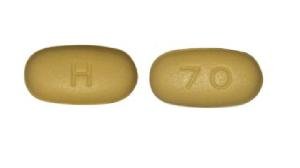Lopinavir/ritonavir and Alcohol/Food Interactions
There are 4 alcohol/food/lifestyle interactions with lopinavir / ritonavir.
Ritonavir Food/Lifestyle
Moderate Food Interaction
Consumer information for this interaction is not currently available.
ADJUST DOSING INTERVAL: Administration with food may modestly affect the bioavailability of ritonavir from the various available formulations. When the oral solution was given under nonfasting conditions, peak ritonavir concentrations decreased 23% and the extent of absorption decreased 7% relative to fasting conditions. Dilution of the oral solution (within one hour of dosing) with 240 mL of chocolate milk or a nutritional supplement (Advera or Ensure) did not significantly affect the extent and rate of ritonavir absorption. When a single 100 mg dose of the tablet was administered with a high-fat meal (907 kcal; 52% fat, 15% protein, 33% carbohydrates), approximately 20% decreases in mean peak concentration (Cmax) and systemic exposure (AUC) were observed relative to administration after fasting. Similar decreases in Cmax and AUC were reported when the tablet was administered with a moderate-fat meal. In contrast, the extent of absorption of ritonavir from the soft gelatin capsule formulation was 13% higher when administered with a meal (615 KCal; 14.5% fat, 9% protein, and 76% carbohydrate) relative to fasting.
MANAGEMENT: Ritonavir should be taken with meals to enhance gastrointestinal tolerability.
Lopinavir Food/Lifestyle
Moderate Food Interaction
Consumer information for this interaction is not currently available.
ADJUST DOSING INTERVAL: Food significantly increases the bioavailability of lopinavir from the oral solution formulation of lopinavir-ritonavir. Relative to fasting, administration of lopinavir-ritonavir oral solution with a moderate-fat meal (500 to 682 Kcal; 23% to 25% calories from fat) increased lopinavir peak plasma concentration (Cmax) and systemic exposure (AUC) by 54% and 80%, respectively, whereas administration with a high-fat meal (872 Kcal; 56% from fat) increased lopinavir Cmax and AUC by 56% and 130%, respectively. No clinically significant changes in Cmax and AUC were observed following administration of lopinavir-ritonavir tablets under fed conditions versus fasted conditions. Relative to fasting, administration of a single 400 mg-100 mg dose (two 200 mg-50 mg tablets) with a moderate-fat meal (558 Kcal; 24.1% calories from fat) increased lopinavir Cmax and AUC by 17.6% and 26.9%, respectively, while administration with a high-fat meal (998 Kcal; 51.3% from fat) increased lopinavir AUC by 18.9% but not Cmax. Relative to fasting, ritonavir Cmax and AUC also increased by 4.9% and 14.9%, respectively, with the moderate-fat meal and 10.3% and 23.9%, respectively, with the high-fat meal.
MANAGEMENT: Lopinavir-ritonavir oral solution should be taken with meals to enhance bioavailability and minimize pharmacokinetic variability. Lopinavir-ritonavir tablets may be taken without regard to meals.
Switch to professional interaction data
Ritonavir High Cholesterol (Hyperlipoproteinemia, Hypertriglyceridemia, Sitosterolemia)
Moderate Potential Hazard, Moderate plausibility
PIs - hyperlipidemia
Treatment with ritonavir alone or in combination with other protease inhibitors (e.g., lopinavir, saquinavir, tipranavir, fosamprenavir) has resulted in substantial increases in the concentration of total cholesterol and triglycerides. These effects have also been reported with other protease inhibitors but may be the most dramatic with ritonavir. The clinical significance of these elevations is unclear. Marked elevation in triglyceride levels is a risk factor for development of pancreatitis. Triglyceride and cholesterol testing is recommended before starting ritonavir (with or without other protease inhibitors) and periodically during therapy. Lipid disorders should be managed as clinically appropriate.
Lopinavir High Cholesterol (Hyperlipoproteinemia, Hypertriglyceridemia, Sitosterolemia)
Moderate Potential Hazard, Moderate plausibility
PIs - hyperlipidemia
Treatment with ritonavir alone or in combination with other protease inhibitors (e.g., lopinavir, saquinavir, tipranavir, fosamprenavir) has resulted in substantial increases in the concentration of total cholesterol and triglycerides. These effects have also been reported with other protease inhibitors but may be the most dramatic with ritonavir. The clinical significance of these elevations is unclear. Marked elevation in triglyceride levels is a risk factor for development of pancreatitis. Triglyceride and cholesterol testing is recommended before starting ritonavir (with or without other protease inhibitors) and periodically during therapy. Lipid disorders should be managed as clinically appropriate.
Switch to professional interaction data
Lopinavir/ritonavir drug interactions
There are 819 drug interactions with lopinavir / ritonavir.
Lopinavir/ritonavir disease interactions
There are 5 disease interactions with lopinavir / ritonavir which include:
More about lopinavir / ritonavir
- lopinavir/ritonavir consumer information
- Check interactions
- Compare alternatives
- Pricing & coupons
- Reviews (5)
- Drug images
- Side effects
- Dosage information
- During pregnancy
- Drug class: protease inhibitors
- En español
Related treatment guides
Drug Interaction Classification
| Highly clinically significant. Avoid combinations; the risk of the interaction outweighs the benefit. | |
| Moderately clinically significant. Usually avoid combinations; use it only under special circumstances. | |
| Minimally clinically significant. Minimize risk; assess risk and consider an alternative drug, take steps to circumvent the interaction risk and/or institute a monitoring plan. | |
| No interaction information available. |
See also:
Further information
Always consult your healthcare provider to ensure the information displayed on this page applies to your personal circumstances.


